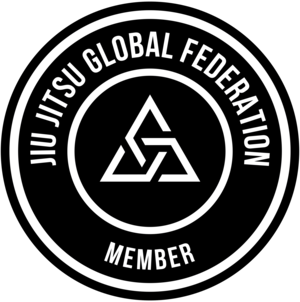
Call 9820496752 or SMS 9969022229

We are a Certified Affiliate Academy under legendary BJJ Grandmaster Rickson Gracie's Jiu Jitsu Global Federation with Certified Black Belt Member status. We teach No Gi Jiu- Jitsu for fitness & fun. Brazilian Jiu-Jitsu (BJJ) is based upon grappling and ground fighting with the aim of gaining a dominant position and using joint-locks and chokeholds to force submission. It has the principle that a smaller, weaker person using leverage and proper technique can successfully grapple against a bigger and stronger assailant.
BJJ is founded on the concept that a smaller, weaker person can successfully defend themselves against a bigger, stronger, heavier opponent. This is done by using technique, leverage, and most notably, taking the fight to the ground, and then applying joint locks and chokeholds to defeat the opponent. BJJ training can be used for sport grappling tournaments and in self-defense situations. Sparring (commonly referred to as “rolling” within the BJJ community) and live drilling play a major role in training and the practitioner’s development.
The advantage of a larger, stronger opponent comes from superior reach and more powerful strikes, both of which are negated if on the ground. BJJ includes many techniques to throw or drag opponents to the ground using the hips and shoulders. Once the opponent is on the ground, a number of skills manipulate the opponent into suitable position for the application of a submission hold. Achieving a dominant position on the ground is one of the hallmarks of the BJJ style, and includes effective use of the guard position to defend oneself from bottom, and passing the guard to dominate from top position with side control, mount, and back mount positions
BJJ focuses on submissions without the use of strikes, while training allows practitioners to practice at full speed and with full strength, resembling the effort used in competition. BJJ Training methods include technique drills in which techniques are practiced against a non-resisting partner; isolation sparring (commonly referred to as positional drilling) where only a certain technique or sets of techniques are used; and full sparring where each practitioner tries to submit their opponent through technique. BJJ has Physical conditioning which is also an important aspect of training.
The majority of submission holds can be grouped into two broad categories: joint locks and chokes. Joint locks typically involve isolating an opponent’s limb to force the joint to move beyond its normal range of motion and signals defeat by submitting. Alternatively, one could apply a choke hold, disrupting the blood supply to the brain, causing unconsciousness if the opponent refuses to tap out. A third, and less common type of submission hold is a compression lock, where the muscle of an opponent is compressed against a hard, large bone (commonly the shin or wrist), causing significant pain to the opponent.
However, most joint locks involving the wrist, elbow, shoulder or ankle are permitted. This includes driving knuckles into pressure points, holding their opponent’s head in order to tire out the neck (called the “can opener”) and putting body weight on top of the sternum, floating ribs.
Most BJJ 'Strangles' involve constriction of the carotid artery and 'Chokes' involving constriction of the windpipe. Blood chokes (strangulations) directly cut the flow of blood off to the opponent’s brain causing a rapid loss of consciousness without damaging the internal structure like Air Chokes which damage Trachea. Being 'choked-out' in this way is actually relatively safe as long as the choke is released soon after unconsciousness.
Sport Brazilian Jiu-Jitsu's focus on submissions without strikes. Training methods include technique drills in which techniques are practiced against a non-resisting partner.